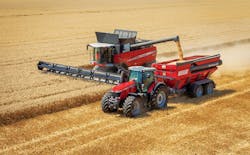Any good engineer knows that all the problems of the world can be solved in one of two ways: duct tape (if it moves, but shouldn’t) or WD-40 (if it should move, but doesn’t). And yet when IT’s solution for too many dropped tablets on the factory floor at Agco was to tape them to the employees, the engineers thought there must be a better way.
The answer, in that case, was wearables. They bought their first Google Glass set to give it a try, and have never looked back.
Agco, headquartered in Duluth, Ga., is a 28-year-old manufacturer of farm equipment. Its facility in Jackson, Minn., specializes in tractors and sprayers. It is a very low-volume, high-complexity environment where almost all equipment is made to order.
After each piece of equipment is made, it must be checked thoroughly to ensure that everything is in working order. Trying to solve problems with non-conformance issues not being reported in a timely manner and also concerns about safety risk, the company put tablets in place in 2013 to enable the reporting to be done more directly. Not only did this create a risk of its own as employees climbed tractors now with one hand while holding the tablet in the other, but the IT department wasn’t thrilled about the high number of tablets that got knocked off of tractors and broken. The solution, as mentioned previously, was duct tape, attaching the tablets directly to the people.
But then wearables entered the scene, and seemed like the perfect solution. “Google Glass came out and we said, ‘Let’s try it,’” said Peggy Gulick, director of business process improvement at Agco. “We paid $1,500 for one Glass; now look where we are today. It was well worth the investment.”
Where Agco is today is using Google Glass throughout its quality management system. Presenting her company’s positive results at the Industry 4.0 ThinkTank conference this week in Chicago, Gulick showed a video in which an employee—with the help of a checklist embedded in his Glass—cycles through all the points to check for quality conformance, orally indicating his progression to the software. Each non-conforming item is recorded immediately while the employee carries on with his check.
“We’ve seen a 33 percent process time reduction in the quality area,” Gulick said. “That doesn’t even incorporate the non-conforms and how much faster we’re responding to that.”
And it’s not just in quality management that Agco has found the wearable technology useful. It has also improved productivity and lowered defect rates in equipment assembly, where employees are now equipped with Google Glass to receive work instructions.
In order to maintain the flexibility it needs to get the jobs done at any given time, Agco has a policy that every employee must be able to do three jobs exceptionally well, and every work function must have three people who can perform it exceptionally well. “That’s very hard to achieve,” Gulick said. “But now it’s all in Glass, so anyone can do the job.”
Laundry list of innovations
It’s not just wearables that Agco has taken and run with. If you ask Gulick which innovations are most useful in smart manufacturing—wearables, augmented reality, connected devices, collaborative robotics—her answer is yes. “Everything has its context,” she said. “We kind of got our fame in wearables because it wasn’t being done in manufacturing. But they all have their place and their value.”
Though wearables are a strong component of Agco’s smart connected factory, Gulick said, they’re also working with automated guided vehicles (AGVs), personal motion sensors (to help improve ergonomic issues), Andon watches, virtual reality and additive manufacturing (they brought in high school students to set up their 3D printers for them).
Gulick is a huge proponent of finding uses for whatever innovations her team can get their hands on. Employees are encouraged to submit ideas for further innovation in a culture that continually strives for improvements in quality, safety and efficiency.
“We hear about a cool tool and we figure out where to use it,” she said. “We get jazzed up because we realize all these things coming out—they’re not scary, they’re filling up our toolbox.”
That toolbox starts with Lean. “We believe our Lean environment is the backbone for most of what we’re doing here,” Gulick said during a panel discussion, emphasizing that the innovative tools available today add to that backbone. “They just make our Lean toolbox fatter and broader and bigger.”
Gulick emphasized also that Agco has not lost any employees as a result of the innovations put in place. “It’s all about helping them do their jobs better,” she said. “We’re trying to connect machines to people so we can use our people to the best possible advantage.”
Meanwhile, they’re seeing the results: “We’ve seen anywhere from 25 to 50 percent process improvement with these tools on the floor,” Gulick said. “Defects have gone down, productivity has dramatically improved. And it’s incredible how quickly we can train employees now with some of these tools on the floor.”

